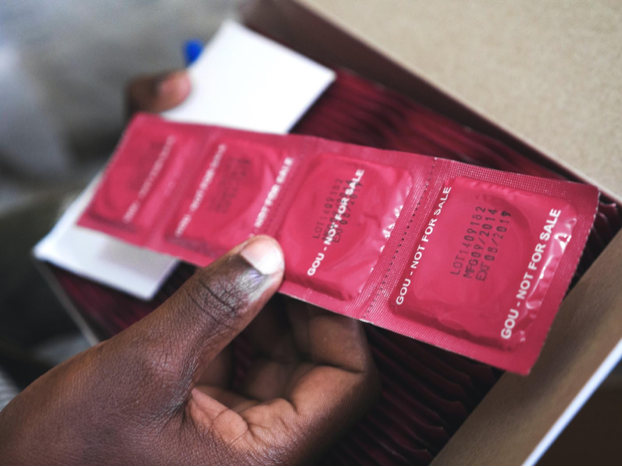
There are many reasons why one might seek out illegal drugs. For many people, taking illegal drugs is a method of escaping reality; of seeing, feeling, and thinking differently; and of exploring the world they know from an altered perspective. Some take drugs for the purpose of fitting into social settings, some to cope with grief, and others may try drugs out of boredom. No matter the reason for ingesting illegal substances, people choosing to do so should use these drugs in a safe setting with the understanding that there may be health or legal consequences. The prospect of an ecstasy experience is especially enticing to young people, and substance use is often closely associated with clubs, concerts, parties, and other venues frequented by adolescents and young adults.
This article explains the experience of ecstasy as it relates to the sexual experience. Some people who have used ecstasy remark on its ability to increase feelings of sensuality and closeness with one’s partner during sex. While these sensations can be enjoyable in the moment, sex under the influence of ecstasy (as well as any mind-altering substance) can present inconvenient or dangerous consequences after its effects have worn off. The following sections present a detailed view of ecstasy through multiple lenses, expanding upon its chemical and social effects, as well as what can be expected when one chooses to mix the experience of using the drug and having sex.
Table of Contents
What is Ecstasy?
MDMA (or 3, 4-methylenedioxymethamphetamine) is an illegal stimulant and hallucinogenic drug more commonly known as “ecstasy,” “Molly,” “X,” or “E”.12 Most frequently, users of ecstasy ingest the substance orally, although there are other methods in use as well. Ecstasy was first synthesized by German chemists in 1912 who wanted to research potential remedies to stop bleeding, but the substance was not commonly used recreationally until its psychoactive properties were discovered, and it was not popular in society until the late 1980s.6 Ecstasy is classified as a Schedule I drug, meaning there is a high probability of addiction occurring and no accepted value for the drug in a medical setting.6 This legal classification has driven ecstasy’s distribution and consumption underground, making the recreational use of the drug potentially life-threatening.7 There are modern scientific studies that aim to challenge this classification by attempting to use MDMA in clinical settings, however, these studies are scarce.8 As such, the academic literature on ecstasy -let alone sex and ecstasy- is limited.
The drug is most often recognized for its recreational use as a “club drug,” as young adults on the lively scenes of raves and dance clubs appear to be its most frequent users.10Ecstasy increases the activity of neurotransmitters, mainly serotonin, causing the drug’s characteristic increases in mood.15 Serotonin (5-HT) regulates impulsivity and executive functions such as decision-making and is the primary target of ecstasy in the brain.9 In fact, studies show that MDMA users possess significantly elevated impulsivity levels during use.18 This can be problematic to users, especially when deciding to engage in sexual intercourse, as choices made while under the influence may differ from choices that would typically be made sober. For this reason, consent may be difficult to obtain while on ecstasy.
Risks Associated with Ecstasy
Although a sought-after “party drug,” ecstasy is still an illegal substance that can be dangerous and even fatal. Its side effects are shown to cause numerous health complications, and in some cases, prove fatal to the user.7 Studies reveal that ecstasy dramatically harms nerves containing serotonin, and customary human dosages have the potential to damage the system.19 Heavy and extended use of the drug has been shown to cause depression, confusion, and memory impairment.15 In addition to its long-term detriments, ecstasy can cause the user to experience short-term – and in some cases, life-threatening – side effects. For example, the increase in mood and excitement associated with an ecstasy high can lead to increased dancing or physical activity, prolonged dehydration, and overall exhaustion.5 Further, laboratory studies on experiences during MDMA use have observed bodily reactions of increased heart rate and blood pressure, rapid breathing, thirst, jaw-clenching, increased internal body temperature (hyperthermia), organ failure, and death.15 In more rare cases, heart failure can occur in otherwise healthy individuals.7
Due to serotonin depletion, it is common for users to experience a post-ecstasy feeling of depression for several days called the “comedown.” Ecstasy has also been found to have slightly distinctive effects on males and females respectively, but no researchers have investigated this effect on gender non-binary individuals. Statistics show that, overall, there are more ecstasy-related male deaths than female deaths.2 This is due to the fact that people with penises tend to consume larger amounts of ecstasy (in addition to other drugs) than do people with vulvas, which contributes to the higher average. People with vulvas who take ecstasy are more likely to experience hyponatremia, which is marked by low blood sodium levels caused by excess water intake.21 Two common side effects of ecstasy are hyperthermia (increased body temperature) and increased thirst, which may influence susceptibility to hyponatremia. People with vulvas also report that the effects of ecstasy last for longer periods of time than people with penises have expressed.2
There are crucial differences between controlled (clinically administered) and recreational use of MDMA. When used recreationally, ecstasy can potentially be mixed with other dangerous types of psychoactive substances, causing experiences to vary greatly from those described by laboratory scientists.5 Pills may be ingested in combination with alcohol or other drugs or may have been combined with separate substances prior to purchase by the user. As ecstasy is an illegal and unregulated psychoactive substance, its use outside of controlled laboratory settings is not recommended, especially considering that recreational drug manufacturers often do not have the users’ best interests in mind.
Why Do People Take Ecstasy?
Branded a “club drug” for its frequent use in party-like settings, ecstasy has the ability to enhance one’s bodily sensations while they are under the influence. Users may experience spikes in energy levels which facilitate dancing for long periods of time, increased mood and happiness, and the desire to be social and interact closely with the people around them.20 People especially enjoy being touched when using ecstasy, as the tactile experience is magnified. Given its ability to enhance the senses, ecstasy can alter the sexual experience. It is in this respect that sex becomes a notable element of ecstasy use.

Ecstasy users report experiencing an altered state of consciousness that changes the way they think and feel while under the influence. In a study conducted on the influence of MDMA on communication with significant others, researchers discovered a connection between the administration of the drug and the emotional nature of the conversation. Participants under the influence of ecstasy spoke of those close to them in a deep, positive, and empathetic way. These subjects also exhibited increased use of social and sexual terms, which reinforces the uninhibited nature of ecstasy users.3 Evidence repeatedly points to the fact that ecstasy fuels an increased desire for social interaction, which continues to attract young users in social situations.3 , 5, 23
Combining Sex and Ecstasy
The body of research concerning ecstasy and sex is limited. Research that has been conducted on the topic presents mixed results, but the vast majority of research agrees that while ecstasy can increase sexual desire, the drug is known to inhibit sexual functioning.16, 20 Ecstasy is often described as a bonding drug, sometimes leading to affectionate physical contact such as touching, hugging, or cuddling. Most users do not express a desire for penetrative sex or initiating sex at all while high, but simply experience increased feelings of sensuality. A study interviewing those who have had experiences on ecstasy found that while ecstasy and sexual feelings are associated with one another, penetrative sex is not as popular: “There’s sexual energy about the whole thing but it’s not about finding someone . . . You want to be close to people and there’s a touchy feely thing about it but it’s not about penetrating sex.” 14 Ecstasy is known to increase arousal, yet this is largely sympathetic, as its effects are more closely associated with emotional connection and close, affectionate touching than erotic interaction. In a study conducted on the effects of psychoactive substances on sexual arousal and response, MDMA did not seem to affect subjects’ responses toerotic images. It did, however, reveal slight increases in response to implicit sexual images (those with implied, rather than explicit, erotic content).20

Even though feelings of affection and sensuality are often reported, ecstasy is known to impair the sex drive along with sexual functioning which can make it difficult for people with penises to get an erection and prevent adequate lubrication for people with vulvas.16 This impairment of sexual functioning is a common theme with substances that alter serotonin levels, as the same phenomenon occurs in drugs used for treating depression. Researchers have found that ecstasy produces what is described as a post-orgasmic state, marked by a release of prolactin at levels similar to sober individuals post-orgasm.16 Additionally, oxytocin, which is often referred to as the “love hormone,” is released which reinforces emotional bonds.16 The release of prolactin and oxytocin helps explain why the desire for physical touch such as cuddling is a common side effect of ecstasy. Just as there is often a strong desire for physical, non-sexual contact post-orgasm, MDMA users experience many of the same types of desires given the similarity in chemical states. Since sex can be difficult for some people on ecstasy, if a decision is made to have sex while on the drug, it should be with someone who is trustworthy and understanding. Under the right circumstances, when consent is obtained, many people have very positive experiences with sex on ecstasy. Considering the fact that ecstasy users alter their brain chemistry and functioning while on the drug, an inability to perform sexual acts while impaired is completely normal and should not be a cause for distress.
While most heterosexual users feel no increased desire to engage in penetrative sex, some gay and bisexual people with vulvas have reported using MDMA specifically to enhance their sexual experience. Users report an emphasis on feelings of well-being, interpersonal closeness, and sensuality that are not necessarily accompanied by sexuality.20 This reinforces the concept of interactional experience that many users speak of: although they may not feel an amplified need for sex itself, they may desire the affection and intimacy that often accompanies sexual encounters. One study interviewed subjects who described what sex was like on ecstasy: “Sex with ecstasy, it’s kind of like well…it’s kind of like having sex when you’re drunk. You just feel more relaxed. You feel everything’s a little more sensitive. Just like the touch or the kiss. It seems like it’s more passionate. It kind of seems like you’re in a sleazy romance novel.” 2
While its effects do provide more intimate social and interactive experiences, the use of ecstasy may increase one’s chances of engaging in high-risk sexual activity.10 Records of people describing their experiences with MDMA explain how one’s perception of reality alters in a way that certain people may look more attractive than normal and sexual activities that may be aversive while sober is suddenly intriguing while under the influence.14 Some people feel regret after having sex while using ecstasy because they may not have chosen to engage in sexual activity or perhaps because they engaged in risky sex practices impulsively.14 Consent may be difficult to obtain while under the influence so it is not recommended to engage in sexual activity unless all partners are sure they have obtained voluntary informed consent. Doing so will preserve the well-being of all participants. If you feel you have been the victim of sexual assault or harassment, we highly recommend seeking help and calling the sexual assault hotline provided at the bottom of this article.

With the potential to impair decision-making, ecstasy increases the likelihood of engaging in unprotected sex with casual partners, thus increasing the risk of unwanted pregnancies and contracting STIs, or sexually transmitted infections.11, 17 A study of ecstasy use and STI prevalence in juvenile detainees revealed a correlation between the drug, the risky sexual behaviors that accompany its use, and the consequences thereof. Some people identifying as males or females who used the drug prior to incarceration reported symptoms of STIs, with people with penises experiencing penile drips or discharge, people with vulvas noting vaginal discharge, odors, or deep pelvic or vaginal pain during sex, and both describing sore bumps on or around their genitals.23 Ecstasy use is especially common among young people and can be attributed to a younger age of consensual penetrative sex. Therefore, adolescents who partake in MDMA use are increasingly susceptible to STIs, such as HIV/AIDS, because they are more likely to A person holding a strip of condoms. ^ engage in unsafe sexual practices.23 It is recommended that participants always be prepared and practice safe sex when with a partner in order to avoid unwanted pregnancies and STIs. This can take the form of regular STI testing, birth control, condom use, and open communication.
Chronic abuse of ecstasy has been shown to deteriorate stages of the sexual response cycle. Given ecstasy’s ability to drastically increase serotonin production, prolonged use can lead to long-term sexually inhibitory effects.19 A study of male rats revealed that ecstasy disrupts sexual response and also impairs sexual reward mechanisms.17 Studies also show that poly-drug use, or the intake of multiple types of drugs simultaneously, can increase the likelihood of risky sexual practices. Several studies reveal a greater prevalence of unprotected sex, unwanted pregnancies, and contraction of STIs among subjects who report having used multiple drugs.5
“Sextasy”
Sextasy is the name used to refer to the combination of ecstasy and Viagra, the anti-impotency drug that works by increasing the temporal length of an erection. Sextasy is known for its stimulating effect (ecstasy) and its ability to enhance sexual ability (Viagra). By combining the two, users attempt to achieve a greater euphoric experience than can be felt by using just one or the other. The sextasy trend is most common among both heterosexual and homosexual young people with penises who frequent clubs, yet this has not been observed in younger adolescents.1 The dangers of using sextasy have become more notable due to the occurrence of heart problems caused by increased blood flow. Since both ecstasy and Viagra serve to dilate the blood vessels, a rapid increase in flow puts a person at a much greater risk for heart attack and stroke.4 Even more alarming is the possibility of developing serotonin syndrome which is marked by a build-up of excess serotonin in the body.12 Too much serotonin in the body can cause confusion, tremors, hallucinations, and disorientation. In more severe cases, serotonin syndrome can cause seizures, an irregular heartbeat, coma, or if left untreated, even death.12 Sextasy can also increase one’s chances of contracting sexually transmitted diseases. Ecstasy’s dis-inhibitory effects combined with Viagra’s enhanced erectile functions can lead to more cases of unprotected sex among users.1 Another risk of combining ecstasy and Viagra is priapism – a potentially painful medical condition in which the erect penis or clitoris does not return to its flaccid state within four hours, despite the absence of both physical and psychological stimulation.1 While combining ecstasy and Viagra can produce enjoyable effects, the consequences of taking them together can be quite harmful and thus, is strongly discouraged.
Ecstasy and Pregnancy

Although there is a limited field of research surrounding the effects of MDMA on pregnancy and infants, studies do show that the drug can influence fetuses both inside and outside of the womb. People with vulvas who use amphetamines during pregnancy are more likely to experience pre-eclampsia – a condition in which an expectant mother will have high blood pressure and an increased amount of protein in the urine – and premature deliveries.13 Birth defects can often be observed prior to birth, while other developmental difficulties may reveal themselves as a baby grows. Findings of a study conducted with UK mothers who had used the drug during their pregnancy indicated that, of 78 live-born infants, 12 displayed congenital defects (2 with cardiovascular and 3 with musculoskeletal anomalies).22 Further, delayed motor abilities have been reported in infants affected by a mother’s prenatal MDMA use, as well as developmental difficulties and milestone delays during the first two years of life. This can be attributed to the development of smaller brain structures associated with amphetamine use during pregnancy.6 While not all birth defects mentioned are directly linked with ecstasy, they are often caused by its use in combination with other types of drugs and alcohol. The combination of ecstasy with other drugs is especially prevalent when ingesting pressed pills because they are often mixed or “cut” with other substances.
Concluding Remarks
Ecstasy is a common illegal club drug often used by people to enhance the experience of concerts, raves, and parties. It activates increased production of the neurotransmitter serotonin, causing the user to feel enhanced sensory stimulation, higher energy, and desire for closeness and interpersonal interaction. While it may not directly increase one’s desire for sex, it can make a person feel more sensual and passionate toward their partner. Sex under the influence of ecstasy can be risky, as lowered inhibitions may lead to unprotected sex and resulting complications, such as unwanted pregnancies and STIs. As a member of the amphetamine drug family, ecstasy does have the potential to harm a fetus if used while pregnant, and long-term use can result in depression, cognitive and memory impairment, and decreased sexual response. Still, many people report pleasant experiences engaging in sex while using ecstasy. If one decides to partake in the experience, they should proceed with caution, making sure they obtain the drug from a trusted source and are in a safe setting. The lines of consent may be blurred while under the influence, so if there are concerns about sexual assault, the National Sexual Assault Hotline is always available: 1-800-656-4673.

References
1. ABC News. (2006, January). Ecstasy-Viagra Combo Grows Popular in Clubs. ABC News.
2. Allott, K., & Redman, J. (2007). Are there sex differences associated with the effects of ecstasy/3,4-methylenedioxymethamphetamine (MDMA)? Neuroscience & Biobehavioral Reviews, 31(3), 327–347. https://doi.org/10.1016/j.neubiorev.2006.09.009
3. Baggott, M. J., Kirkpatrick, M. G., Bedi, G., & de Wit, H. (2015). Intimate insight: MDMA changes how people talk about significant others. Journal of Psychopharmacology, 29(6), 669–677. https://doi.org/10.1177/0269881115581962
4.Edgley, R. (2014, March). “The Rise of Viagra abuse: Doctors warn against worrying ‘sextasy’ trend – where ecstasy is mixed with drug to enhance euphoria.” dailymail.co.uk. The Daily Mail.
5. Garcia-Romeu, A., Kersgaard, B., & Addy, P. H. (2016). Clinical applications of hallucinogens: A review. Experimental and Clinical Psychopharmacology, 24(4), 229–268. https://doi.org/10.1037/pha0000084
6. History.com Editors. (2017, May 31). MDMA. History.com.
7. Kafle, P., Shrestha, B., Mandal, A., Sharma, D., Bhandari, M., Amgai, B., Khalid, M., Sidhu, J. S., Solaimanzadeh, I., Gayam, V., Surana, R., & Dufresne, A. (2019). Ecstasy induced acute systolic heart failure and non-ischemic cardiomyopathy in a young female: A rare case report and literature review. Journal of Community Hospital Internal Medicine Perspectives, 9(4), 336–339. https://doi.org/10.1080/20009666.2019.1650593
8. Krystal, J. H., Kelmendi, B., & Petrakis, I. L. (2021). Psychotherapy-supported MDMA treatment for PTSD. Cell Reports Medicine, 2(8), 100–378. https://doi.org/10.1016/j.xcrm.2021.100378
9. Kubicek, K., McDavitt, B., Carpineto, J., Weiss, G., Iverson, E. F., & Kipke, M. D. (2009). Making informed decisions: How attitudes and perceptions affect the use of crystal, cocaine, and ecstasy among young men who have sex with men. Journal of Drug Issues, 37(3), 643–672. https://doi.org/10.1177/002204260703700308
10. Mattews, A., & Bruno, R. (2015, December). Sex and Drugs: Sexual Risk Behavior among Regular Psychostimulant Consumers in Australia. NDARC Drug Trends: National Drug and Alcohol Research Center.
11. May, A. L., & Parrott, A. C. (2015). Greater sexual risk-taking in female and male recreational MDMA/Ecstasy users compared with Alcohol Drinkers: A Questionnaire Study. Human Psychopharmacology: Clinical and Experimental, 30(4), 272–275. https://doi.org/10.1002/hup.2432
12. Mayo Foundation for Medical Education and Research. (2019, December 10). Serotonin syndrome. Mayo Clinic.
13. McDonnell-Dowling, K., & Kelly, J. P. (2015). Sources of variation in the design of preclinical studies assessing the effects of amphetamine-type stimulants in pregnancy and lactation. Behavioural Brain Research, 279, 87–99. https://doi.org/10.1016/j.bbr.2014.11.021
14. McElrath, K. (2005). MDMA and sexual behavior: Ecstasy users’ perceptions about sexuality and sexual risk. Substance Use & Misuse, 40(9-10), 1461–1477. https://doi.org/10.1081/ja-200066814
15. NIDA. (2006, March). MDMA (Ecstasy) abuse. National Institute on Drug Abuse.
16. Passie, T., Hartmann, U., Schneider, U., Emrich, H. M., & Krüger, T. H. C. (2005). Ecstasy (MDMA) mimics the post-orgasmic state: Impairment of sexual drive and function during acute MDMA-effects may be due to increased prolactin secretion. Medical Hypotheses, 64(5), 899–903. https://doi.org/10.1016/j.mehy.2004.11.044
17. Pfaus, J. G., Wilkins, M. F., DiPietro, N., Benibgui, M., Toledano, R., Rowe, A., & Couch, M. C. (2010). Inhibitory and disinhibitory effects of psychomotor stimulants and depressants on the sexual behavior of male and female rats. Hormones and Behavior, 58(1), 163–176. https://doi.org/10.1016/j.yhbeh.2009.10.004
18. Quednow, B. B., & Liechti, M. E. (2015). Effects of methylphenidate and MDMA on appraisal of erotic stimuli and intimate relationships. European Neuropsychopharmacology, 25(1), 17–25. https://doi.org/10.1016/j.euroneuro.2014.11.020
19. Roberts, C. A., & Montgomery, C. (2015). Cortical oxygenation suggests increased effort during cognitive inhibition in ecstasy polydrug users. Journal of Psychopharmacology, 29(11), 1170–1181. https://doi.org/10.1177/0269881115598412
20. Schmid, Y., Hysek, C. M., Preller, K. H., Bosch, O. G., Bilderbeck, A. C., Rogers, R. D., Quednow, B. B., & Liechti, M. E. (2015). Effects of methylphenidate and MDMA on appraisal of erotic stimuli and intimate relationships. European Neuropsychopharmacology, 25(1), 17–25. https://doi.org/10.1016/j.euroneuro.2014.11.020
21. Simmler, L. D., Hysek, C. M., & Liechti, M. E. (2011). Sex differences in the effects of MDMA (ecstasy) on plasma copeptin in healthy subjects. The Journal of Clinical Endocrinology & Metabolism, 96(9), 2844–2850. https://doi.org/10.1210/jc.2011-1143
22. Soto, E., Bahado-Singh, R., Christensen, C., Chauhan, S., Sibai, B., & Viteri, O. (2014). Fetal anomalies and long-term effects associated with substance abuse in pregnancy: A literature review. American Journal of Perinatology, 32(05), 405–416. https://doi.org/10.1055/s-0034-1393932
23. Stephens, T., Holliday, R. C., & Jarboe, J. (2014). Self-reported ecstasy (MDMA) use and past occurrence of sexually transmitted infections (stis) in a cohort juvenile detainees in the USA. Journal of Community Health, 40(2), 308–313. https://doi.org/10.1007/s10900-014-9936-5
Last Updated: 3 March 2022.
